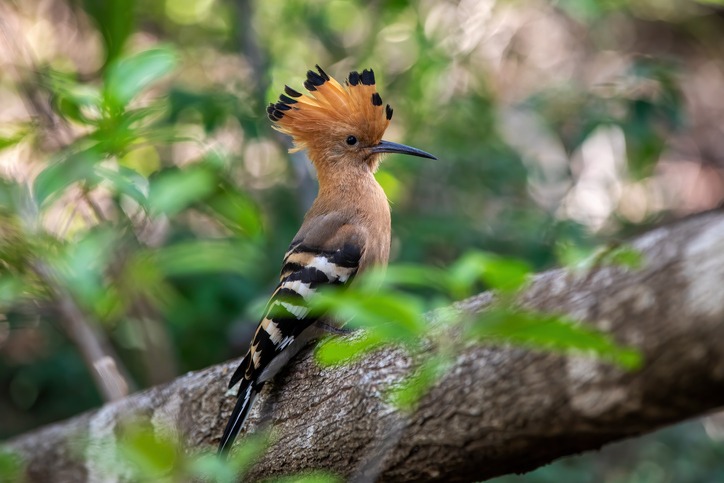The African Hoopoe, or also known as the Upupa Africana, is a bird species under the Upupidae family. This family of colorful birds consists of Eurasian Hoopoe and Madagascan Hoopoe. Back in the day, the African Hoopoe was considered a subspecies of the Hoopoe, with a binomial name Upupa epops Africana.
This bird species was first accounted by a German naturalist and forester Johann Matthäus Bechstein, who gave this bird species its present binomial name, Upupa Africana.
Its name, Hoopoe, came from its repetitive “hooo-pooo” call that is sung five times or more. African Hoopoes are widely distributed throughout the African continent, primarily in open and bushy habitats.
Its seven levels of scientific classification are as follows:
Kingdom: Animalia
Phylum: Chordata
Class: Aves
Order: Bucerotiformes
Family: Upupidae
Genus: Upupa
Species: U. Africana
The physical characteristics of an African Hoopoe
The African Hoopoe is hard to miss. Its distinct crown or crest of rich chestnut feathers with black tips makes this bird easily recognizable. Its plumage is rich chestnut with black and white stripes located at its wings and tail. When the African Hoopoe is surprised or alarmed, it raises its crests.
The African Hoopoe considers its long, decurved ill its most important tool for survival. This long beak allows the bird to forage through the ground to search for food and feed their young. This long, dark, and narrow beak is also utilized during aggressive territorial fights.
The bird’s lower abdomen, under-tail, and belly are white in color. Its eyes are black, and its feet and legs are dark brown in color.
An adult African Hoopoe grows from 25-28 cm and weighs 40-60 g.
The distribution and habitat of African Hoopoes
African Hoopoes are present in African countries such as South Africa (where African Hoopoes are most commonly found), Lesotho, Namibia, Swaziland, Botswana, and Zimbabwe, Mozambique, Zambia, Malawi, Angola, Tanzania, and the southern part of the Democratic Republic of Congo. These birds are also found in nature reserves, wildlife parks, gardens, orchards, and other man-made habitats. These man-made reserves include the Table Mountain National Park, Makana Botanical Gardens, and Melrose Bird Sanctuary.
When it comes to habitats, African Hoopoes take refuge in open lands, bushy areas, riverine woodlands, and thornveld woodlands. It frequents to almost every part of southern Africa except dry habitats such as deserts and arid zones.
The behavior of African Hoopoes
African Hoopoes are not sociable birds. You would usually see them foraging alone or in pairs. Occasionally, they create small flocks during the migration season.
One more exciting thing about these birds is that they like basking in the sun and sand. When they want to relax, African Hoopoes usually gets low to the ground and spreads itself out to absorb energy from sun rays.
These birds also mate for life. During the breeding season, a pair of African Hoopoes will perform a unique courtship display that involves food. The male African Hoopoe will present an insect to a female African Hoopoe. The male then offers the insect to the female as a “nuptial gift.” Indeed, the male African Hoopoe knows that a way to a female’s heart is through the stomach!
If the courtship becomes successful, the African Hoopoes will create nests out of tree holes. Unlike common birds who build nests out of woods and twigs, the African Hoopoes are cavity nesters—they take refuge in natural tree holes or holes carved by woodpeckers or barbets. The male African Hoopoe will always be the one to choose the nest.
The egg-laying season takes place between August-February. A female African Hoopoe then lays 4-7 eggs. It takes two days before laying another egg. Therefore, the standard egg-laying period for female African Hoopoe happens for approximately two weeks.
After laying the last egg, the female African Hoopoe will be responsible for incubating the eggs. The male African Hoopoe will be the one who will do the hunting for its partner. After the incubation period, which happens for 15-16 days, the male will feed the chicks for the first week of their lives. The pair’s chicks will stay in the nest for one month before they become independent from their parents.
An African Hoopoe’s diet
Like common birds, African Hoopoes feed on insects such as grasshoppers, mole crickets, beetles, caterpillars, worms, slugs, and grubs. They also feed on vertebrates, such as lizards, small snakes, and frogs.
BOTSWANA BIRDS | SOUTH AFRICA BIRDS
NAMIBIA BIRDS | ZAMBIA BIRDS | ZIMBABWE BIRDS
